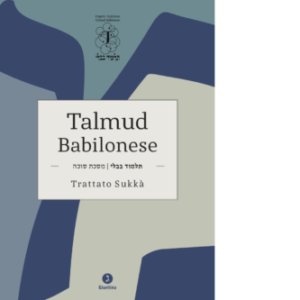Talmud translated into Italian, new tractate available in bookstores
 The Babylonian Talmud Translation Project celebrates a new milestone: the publication of Sukkah (Hut), the eighth tractate to be printed since the beginning of the collaboration between the Jewish, the scientific, and the Italian institutions. The tractate – curated by Rabbi Riccardo Di Segni, rabbi of Rome and chairman of the Talmud Project – focuses on the rituals and customs of Sukkot, the third “of the Three Pilgrimage Festivals prescribed by the Torah, in which it is repeatedly quoted, and it is referenced in other biblical books as well”. A mainly technical tractate, but that also has “great historical importance as it reports the memories of the life at the heart of the ancient Jewish religious practice”.
The Babylonian Talmud Translation Project celebrates a new milestone: the publication of Sukkah (Hut), the eighth tractate to be printed since the beginning of the collaboration between the Jewish, the scientific, and the Italian institutions. The tractate – curated by Rabbi Riccardo Di Segni, rabbi of Rome and chairman of the Talmud Project – focuses on the rituals and customs of Sukkot, the third “of the Three Pilgrimage Festivals prescribed by the Torah, in which it is repeatedly quoted, and it is referenced in other biblical books as well”. A mainly technical tractate, but that also has “great historical importance as it reports the memories of the life at the heart of the ancient Jewish religious practice”.
In an introductory text, the rabbi underlines the fact that Sukkot is placed at a particular time of the calendar, before the arrival of the highly anticipated rainy season and thus marking the end of the annual agricultural cycle. An appointment that is symbolic of “the link with the land and agriculture”, but also “a generic historical reference to the period of dwelling in the desert”. “The moment designated to reflect on the weakness and precariousness of existence” is therefore evoked in many aspects by the symbol of the hut itself. Almost paradoxically, however, the holiday is also an opportunity “to rejoice and celebrate, trusting in the divine protection”. Sukkah was published, as the previous tractates, by Giuntina.
The first chapter deals with the construction of the Hut. It prescribes “its dimensions, maximum and minimum height, minimum base, and shape; its walls, the number and whether they should be complete or poles are enough; what the roof should be like; whether it can stay under another structure or a tree; whether a sukkah made for occasions other than the festival can be used; the materials for the roof, and whether there can be empty spaces or non-vegetable materials”.
The second chapter continues with the presentation of the rules regarding the sukkah, “with matters related to the mode of construction; then it goes on to discuss the requirements that must be fulfilled during the dwelling, such as how many and what type of meals should be consumed, and who is exempted from the obligation”. The third focuses instead on the laws concerning the four plant species.
The rabbi asserts that “it is necessary to identify the species, how many branches or fruits must be taken, and their minimum and maximum size; their condition; whether they must be of exclusive property or can have other properties and origins, whether they must be linked together or not, and how, after taking them, the precept is fulfilled”. With the fourth chapter, attention shifts to another subject: the evocation of the rites dating back to “the times of the Temple, how the Shabbat changed the rules, and what the transition from Sukkot to the festival on the eighth day, Shemini Atzeret, entailed”.
The fifth and final study completes the picture. They were moments of great joy and profound intensity, suggests Rabbi Di Segni: “At night, the lighting was extraordinary, and during the day, a solemn procession accompanied the pouring of water on the altar performed as a libation as it entered the Temple”.
Translated by Annadora Zuanel, revised by Martina Bandini, students at the Secondary School of Modern Languages for Interpreters and Translators of the University of Trieste, interns at the newspaper office of the Union of the Italian Jewish Communities – Pagine Ebraiche.
